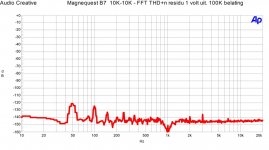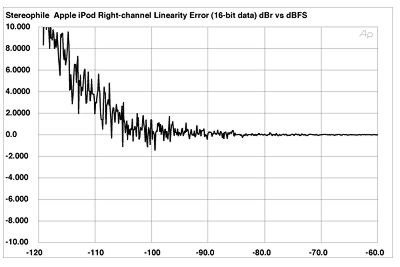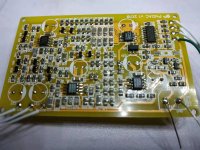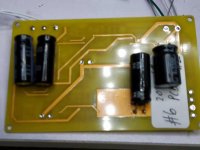I can put them in a small bag along with your 2 kits if you like, they're all values I have to hand. They do need to be NP0.
Your last question I'm not sure I've grasped - if you want to do droop correction in DSP you'll lose a bit of digital headroom but you'll then be wanting a flat filter - the one I've just worked out has a small boost at 20kHz.
That would be great, buying them in small quantities seems to be difficult!
@enregistree - my LCR meter showed an impedance about 1mohm of X and 1mohm of R @10kHz but down at such low levels its tricky to get a reliable reading as getting a good contact isn't easy. I don't know which current production 'lytics achieve the same ESRs - Nichicon HZ seem to come and go in production, various Taobao sellers appear to have them at the moment.
Thanks abraxalito, at least one can be sure they are not fakes as soon as ESR is measured.
I use ferrite because its easily available (just down the road there's an electronics market) and because its cheap (about 1-2RMB for cores like those). But if the other materials are easy to get hold of and cheap enough I'm open to trying them. Where to source DIY quantities of nano and permalloy cores? I've looked on Taobao and have yet to find...
Abrax,
Permalloy / nano (Finemet) cores are *expensive. There's no real way
around this except larger quantities.
I've seen these cores available through China but I would be very cautious.
As such, if you want a really HQ transformer for DAC OP, Cinemag multifilar,
80% Nickel core output transformers are my choice. I have used a variety
of their transformers on a number of Pro Audio / DAC applications and they are excellent as is their customer service.
These are not cheap but absolutely worth it. Very low distortion if driven
from suitably low source Z and should be superior to what you are using.
As always, with ANY audio transformer, drive a 10kHz square wave through
it in it's intended environment and snub for proper transient response if
required.
Mark - are you ready to re adjust your views on audio transformers applied
to DAC OP? 🙂 🙂
T
Mark - are you ready to re adjust your views on audio transformers applied
to DAC OP?
Not really. Let me put it this way: I would rather try That Corp. or better differential drivers and receivers to see if there is an audible improvement with balanced interconnects. I would then be willing to substitute transformers and see if any further improvement in a particular environment. If transformers clearly help fix a problem then I would use them. Otherwise not, at least for high performance 24-bit dacs. The reason is because we work hard to get distortion down to -120dB, and with AK4499 the target will be -124dB. After working so hard for it, I don't want to give any of it away unless it solves a problem or somebody just likes the sound of transformers (which some people do).
Not really. Let me put it this way: I would rather try That Corp. or better differential drivers and receivers to see if there is an audible improvement with balanced interconnects. I would then be willing to substitute transformers and see if any further improvement in a particular environment. If transformers clearly help fix a problem then I would use them. Otherwise not, at least for high performance 24-bit dacs. The reason is because we work hard to get distortion down to -120dB, and with AK4499 the target will be -124dB. After working so hard for it, I don't want to give any of it away unless it solves a problem or somebody just likes the sound of transformers (which some people do).
Here's an FFT of a decent multifilar OP transformer. Nothing wrong with that. 🙂
They are always worth a try.
T
Attachments
As such, if you want a really HQ transformer for DAC OP, Cinemag multifilar,
80% Nickel core output transformers are my choice. I have used a variety
of their transformers on a number of Pro Audio / DAC applications and they are excellent as is their customer service.
These are not cheap but absolutely worth it. Very low distortion if driven
from suitably low source Z and should be superior to what you are using.
I've no doubt they would have well superior specs but at this stage in DAC development I can't see a reason to totally blow my budget on them. Ferrite transformers I don't find are the bottleneck in my DAC - power supplies still are, I/V stages too. So much so that on the next generation DAC I'm seriously considering adding another trafo - between DAC and I/V stage - to help get better performance out of the I/V.
@TNT - any suggestions for how we might test your idea?
@Abraxalito:
I know you can hand wound special transformers for using in your DAC for isolation purpose. But, can I use ready made isolation transformers from Mouser.in ?
If yes, what should be their specs like voltage range, primary and secondary impedance, inductance etc.
TY-250P Triad Magnetics | Mouser India
Also, can I use a DC blocking capacitor instead of a transformer in your DAC?
Sorry for these noobish questions 😛
I know you can hand wound special transformers for using in your DAC for isolation purpose. But, can I use ready made isolation transformers from Mouser.in ?
If yes, what should be their specs like voltage range, primary and secondary impedance, inductance etc.
TY-250P Triad Magnetics | Mouser India
Also, can I use a DC blocking capacitor instead of a transformer in your DAC?
Sorry for these noobish questions 😛
It looks a little small sized and I can't be sure it'll handle the full voltage swing at 20Hz. It will need a 1kohm load to tame the HF resonance. I guess you'd just have to try it.
DC blocking caps are already included - check the schematic. They don't provide isolation which is the primary reason for including a trafo.
DC blocking caps are already included - check the schematic. They don't provide isolation which is the primary reason for including a trafo.
Oh ok, I just assumed that these were for DC blocking !
Yeah, the frequency response curve is frightening, especially near the 20khz mark.
Yeah, the frequency response curve is frightening, especially near the 20khz mark.
All trafos have a HF peak, its caused by the leakage inductance. Normally an RC 'snubber' is used on the secondary, rather than a straight resistor, to give the source a lighter load at LF where the damping isn't needed.
Upgrading the opamp power supplies
Turns out that its possible (though very fiddly) to give all the AD8017s a much lower supply impedance by means of arrays of caps soldered to the top of the ICs. Its not a portable solution as the 'blades' of capacitors are only held in place by solder but its a fun experiment to try nevertheless to discover what this DAC is capable of.
The top mounted caps need to be bottom mounted to clear enough space (see first two pics) then the blades made out of 10 off 1800uF/16V low ESR caps can be soldered to the power pins of the AD8017s. The raw double-sided PCBs the caps are mounted on are roughly 5cm * 2cm.
@TNT - I don't have access to an AP. Any ideas how to do a linearity test with an ordinary soundcard?
Turns out that its possible (though very fiddly) to give all the AD8017s a much lower supply impedance by means of arrays of caps soldered to the top of the ICs. Its not a portable solution as the 'blades' of capacitors are only held in place by solder but its a fun experiment to try nevertheless to discover what this DAC is capable of.
The top mounted caps need to be bottom mounted to clear enough space (see first two pics) then the blades made out of 10 off 1800uF/16V low ESR caps can be soldered to the power pins of the AD8017s. The raw double-sided PCBs the caps are mounted on are roughly 5cm * 2cm.
@TNT - I don't have access to an AP. Any ideas how to do a linearity test with an ordinary soundcard?
Attachments
I suppose it should be possible with a good soundcard with know linearity, some software (osc/fft) and suitable .wav files.
//
//
Yes I am fairly sure its possible - but is software already available for this? I had a quick play in Audacity with a test waveform I cooked up but I can't see a way to generate a neat plot, other than creating it manually.
I have to admit that I don't know either really. There might be a few approaches; RMS level 1 khz sinus reading, pink noise octave binning mean (energy linearity?) ... more?
Sorry to just offering suggestion/requests but no solution to how.
//
Sorry to just offering suggestion/requests but no solution to how.
//
Building the kits
Since @obscurus has already received the first batch of kits its about time for one or two build notes for PhiDAC.
First up, since the opamps were sourced on Taobao at a rock-bottom price, it turns out they're not all in perfect condition. They're recycled, meaning they're likely removed from their original PCBs by hot air and I've had a small number fail in circuit on first power-up from building about 8 PhiDACs with them so far. To accommodate around 10-15% of likely failures, I'm including an extra 5 opamps per pack of 10 kits.
In order to avoid knock-on failures due to a DAC powering up with a dodgy opamp in-circuit, I recommend using a power supply with a built-in current limit for initial power-up, set to ~100mA. The typical regulated bench supply has such a control but if you're not a seasoned DIYer and can only stretch to a wall-wart for running PhiDAC then I suggest using a 3pin voltage regulator as current limiter. The most suitable looks to be a uA78L10 : UA78L10ACLP Texas Instruments | Mouser This reg needs a minimum input voltage of 12.5V and a maximum of 25V. However at the maximum it'll likely get too hot so I'd suggest 12.5-18V.
The crucial voltages to check on first power-up are the DAC power rail (5.9V) on L21 and the opamp power rail (7.8V) on R56. Also verify the two yellow LEDs light giving 3.9V on R57 and the logic chip sees 2.5V on R25. (All voltages relative to GND). The output offset voltage is a very useful indicator everything's fine - it should be between 3.8 and 4.0V, check both L and R channels on R34 and R11. Note that the DAC chip isn't guaranteed to power on at digital zero so the offset should be checked with an I2S source connected and playing out.
Since @obscurus has already received the first batch of kits its about time for one or two build notes for PhiDAC.
First up, since the opamps were sourced on Taobao at a rock-bottom price, it turns out they're not all in perfect condition. They're recycled, meaning they're likely removed from their original PCBs by hot air and I've had a small number fail in circuit on first power-up from building about 8 PhiDACs with them so far. To accommodate around 10-15% of likely failures, I'm including an extra 5 opamps per pack of 10 kits.
In order to avoid knock-on failures due to a DAC powering up with a dodgy opamp in-circuit, I recommend using a power supply with a built-in current limit for initial power-up, set to ~100mA. The typical regulated bench supply has such a control but if you're not a seasoned DIYer and can only stretch to a wall-wart for running PhiDAC then I suggest using a 3pin voltage regulator as current limiter. The most suitable looks to be a uA78L10 : UA78L10ACLP Texas Instruments | Mouser This reg needs a minimum input voltage of 12.5V and a maximum of 25V. However at the maximum it'll likely get too hot so I'd suggest 12.5-18V.
The crucial voltages to check on first power-up are the DAC power rail (5.9V) on L21 and the opamp power rail (7.8V) on R56. Also verify the two yellow LEDs light giving 3.9V on R57 and the logic chip sees 2.5V on R25. (All voltages relative to GND). The output offset voltage is a very useful indicator everything's fine - it should be between 3.8 and 4.0V, check both L and R channels on R34 and R11. Note that the DAC chip isn't guaranteed to power on at digital zero so the offset should be checked with an I2S source connected and playing out.
Hi i finally got around soldering one kit🙂 Took me about 4 hours by hand but it looks beautiful. I got 3 questions tho;
1. What is the switch for? (phase?)
2. I never located the L24 ferrite, all the others parts checked out, am i missing something? (my board is fully populated)
3. I destroyed 1 LED which type did you use?
I don't have time to listen to it yet, but that will come. Thanks for creating this!
-Chris
1. What is the switch for? (phase?)
2. I never located the L24 ferrite, all the others parts checked out, am i missing something? (my board is fully populated)
3. I destroyed 1 LED which type did you use?
I don't have time to listen to it yet, but that will come. Thanks for creating this!
-Chris
Hi Chris
Glad to hear back from you! When you have time, do post a pic 🙂
1. Yes its a phase invert switch - actually the TDA1387 inverts the signal normally since it was designed to work with a single opamp for I/V so with the switch off the HC86 inverts the data to get it to come out in-phase (two inverting stages after the DAC in PhiDAC). If you don't fit the switch the DAC's non-inverting in phase overall. You can use two boards with one of them inverted to create a balanced DAC.
2. L24 most likely was an inductor on the previous revision which got deleted going to v1. So its not a problem that you couldn't find it 🙂
3. LEDs are yellow 0805, I put a part number in my Mouser BOM let me see.... 749-SM0805YC is Mouser's part no.
Looking forward to hearing how it sounds.
Glad to hear back from you! When you have time, do post a pic 🙂
1. Yes its a phase invert switch - actually the TDA1387 inverts the signal normally since it was designed to work with a single opamp for I/V so with the switch off the HC86 inverts the data to get it to come out in-phase (two inverting stages after the DAC in PhiDAC). If you don't fit the switch the DAC's non-inverting in phase overall. You can use two boards with one of them inverted to create a balanced DAC.
2. L24 most likely was an inductor on the previous revision which got deleted going to v1. So its not a problem that you couldn't find it 🙂
3. LEDs are yellow 0805, I put a part number in my Mouser BOM let me see.... 749-SM0805YC is Mouser's part no.
Looking forward to hearing how it sounds.
I have to confess that I did make 3 Phil DAC but only used it on my headphones. And finally yesterday, I bring one of my philDAC as a present to one of my audio friend. We have a nice listening session with philDAC on his system. Started with some Jazzs, some instruments next and vocals then I had to leave for something else. He said he really like the DAC, he claimed it is better than his TDA1543 and TDA1541 DACs by noticeable margins and very very happy with the present 🙂
All the DAC components come from the KIT except the output capacitor. And we used a Li-ion 12.6V for the PSU.
All the DAC components come from the KIT except the output capacitor. And we used a Li-ion 12.6V for the PSU.
- Home
- Source & Line
- Digital Line Level
- lingDAC - cost effective RBCD multibit DAC design




